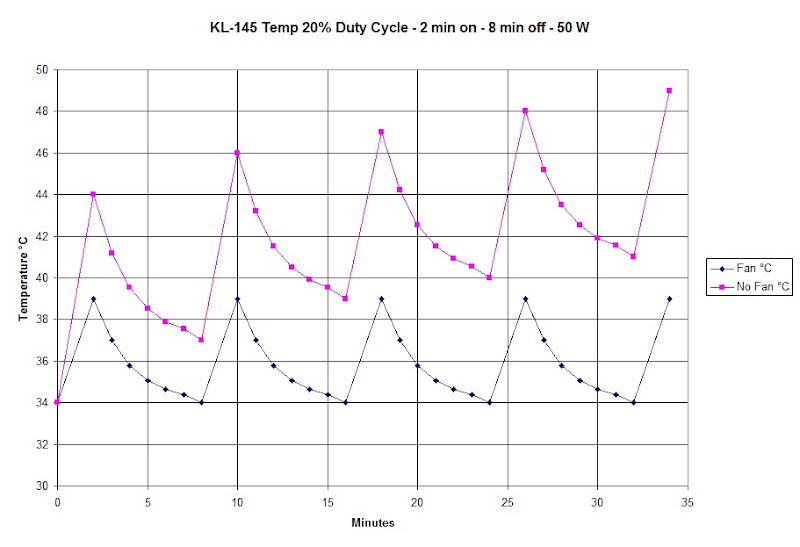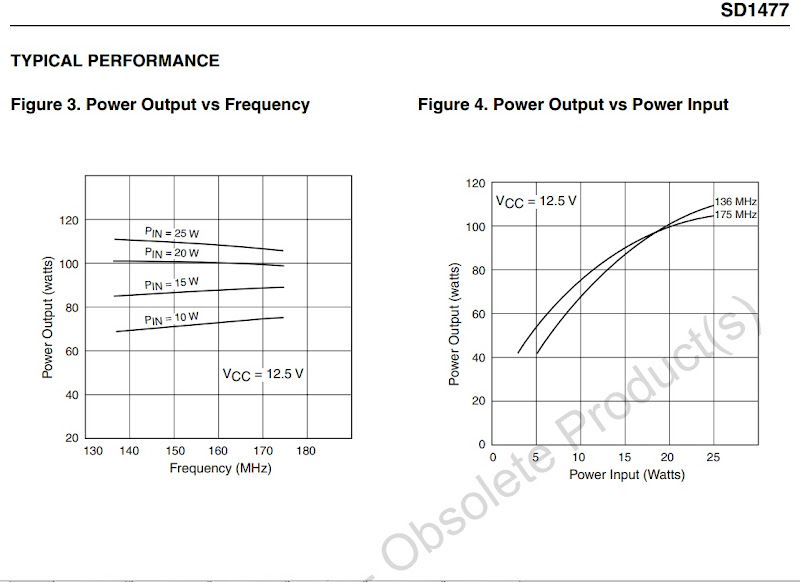The RM Italy KL-145 Linear Amplifier in Digital Mode140-152 MHz Linear Amplifier Performance in WSPR
Mode
|
||
|---|---|---|
|
|
||
|
1. An RM Italy KL-145
Linear Amplifier purchased from DNJ Radio. The
manufacturer's specifications rated this unit at 110
watts output for 25 watts input. 5 watts from my
Elecraft XV144 transverter drove its SD1477 transistor
to 50 watts output. The SD1477 transistor in these
KL-145 amplifiers had a frequent failure rate with
higher applied RF drive as there is no overdrive
protection. RM Italy has replaced the KL-145 listing
with a
LA-145 model that appears externally identical
except for color and is rated at 85 watts output for 4
watts input. |
2. On 18 June 2012 I
put this unit into service at 50 watts output power on
WSPR, a digital mode running 20% duty cycle, 2 minutes
on, 8 minutes off. On 30 June, the amplifier
failed and developed a zero ohm short circuit as
measured across its power cord. The RM Italy
technical support staff promptly responded to my
inquiry, advising that the failure may have been caused
by excessive temperature as the fixed idling current
decreases amplifier efficiency at lower output power
levels. |
3. Here is a
replacement RM Italy KL-145 Linear Amplifier under test
with a SilenX
Effizio EFX-10-12 fan on the heat sink. The
amplifier is being driven to to 55 watts into a 50 ohm
non-reactive load and the DC voltage and current are
being monitored with a Turnigy 130A watt meter. DC
power consumption is 108 watts and the efficiency is
approximately 50%, normal for a linear amplifier.
A temperature probe was placed on the warmest part of
the heat sink to monitor heating during operation. |
|
4. The RM Italy KL-145
amplifier temperature test during WSPR operation.
Without fan cooling, successive transmission cycles at
this duty cycle had caused cumulative temperature rise
eventually causing amplifier failure. With the SilenX
EFX-10-12 fan on the heat sink, the amplifier's
temperature never exceeded 39�C and has been in constant
operation since July 2012. |
5. The WaveNode WN-2 LCD display unit, a precision calibrated digital SWR/Power Meter, interfaces with a computer through a USB serial cable. The WaveNode software displays all parameters, oscilloscope and modulation frequency analyses on the computer monitor. https://wavenodedevelop.com/controllers/wavenode-wn-2/ |
6. Here are two WaveNode UHF-1 RF sensor units, one attached to the input and the other attached to the output of the RM Italy KL-145 linear amplifier. The top cover of the Elecraft XV144 transverter is seen in the foreground. A Waters model 336 coaxial transfer switch is behind the sensor units. |
|
7. PowerSDR running on a FLEX-3000 and a FLEX-1500 with 2 meter transverter, with instances of WSPR for HF and VHF. The WaveNode WN-2 monitors the input power to the RM Italy KL-145 linear amplifier and power output of both transmitters. |
8. The WaveNode WN-2 produced this power vs. gain performance graph for the RM Italy KL-145 amplifier, showing nearly constant gain measured at 11-12 dB from 25 to 100 watts output. Above this level the gain decreases to 8 dB at 150 watts output. This behavior is normal for solid state linear amplifiers. |
9. For comparison, here is a power vs. gain performance graph for the $369 Mirage B-2518-G linear amplifier, also showing similar gain measured at 11-12 dB from 25 to 100 watts output. Above this level the gain decreases to 10 dB at 120 watts output. |
|
10. Here the WaveNode
displays simultaneous input and output measurements of
the RM Italy KL-145 linear amplifier. |
11. The internal view
of the RM Italy KL-145 linear amplifier showing clean,
solid construction and excellent workmanship. |
12. A close-up view
showing the SD1477 transistor in the RM Italy KL-145
linear amplifier. |
|
13. The measured
performance of the RM Italy KL-145 amplifier
approximates the manufacturer's specifications for its
SD1477 transistor. |
14. As the RM Italy
KL-145 linear amplifier's circuit is a basic,
straightforward design, similar to the PA10-80BL
amplifier formerly made by KLM Electronics, the user
must take precautions to avoid excess drive power, SWR
and operating temperature. |
15. The RM Italy KL-145
amplifier performed dependably at 50 watts output on
WSPR mode since July 2012. With the supplemental
cooling fan there was little perceptible heating of the
amplifier during digital mode transmissions. For
typical use, the KL-145 from DNJ
Radio at $130 is an economical alternative to
similar VHF amplifiers in this power range. |







